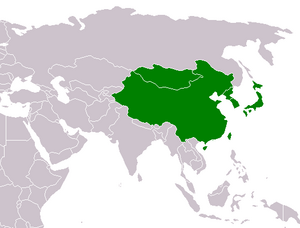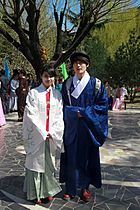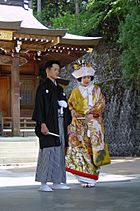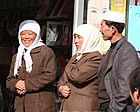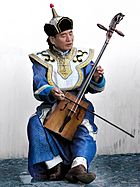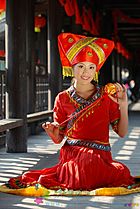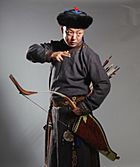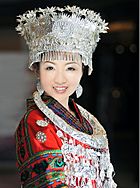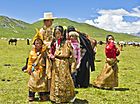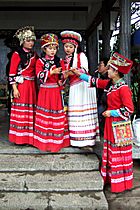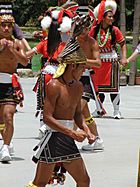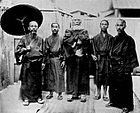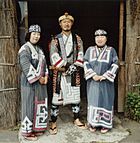East Asia facts for kids
East Asia or Eastern Asia is part of the continent Asia. East Asia covers about 6,640,000 km2 (2,560,000 sq mi), or 15% of the continent.
These are the countries and territories in East Asia:
- People's Republic of China (excluding Tibet which is part of the Indian subcontinent of South Asia)
- Hong Kong
- Japan
- North Korea
- South Korea
- Macao
- Mongolia
- Republic of China (Taiwan)
Population
| State/Territory | Area km2 | Population (2018) |
Population density per km2 |
HDI | Capital/Administrative Center |
|---|---|---|---|---|---|
| 9,640,011 | 1,427,647,786 | 138 | 0.752 | Beijing | |
| 1,104 | 7,371,730 | 6,390 | 0.933 | Hong Kong | |
| 30 | 631,636 | 18,662 | 0.909 | Macao | |
| 377,930 | 127,202,192 | 337 | 0.909 | Tokyo | |
| 1,564,100 | 3,170,216 | 2 | 0.741 | Ulaanbaatar | |
| 120,538 | 25,549,604 | 198 | 0.733 | Pyongyang | |
| 100,210 | 51,171,706 | 500 | 0.903 | Seoul | |
| 36,197 | 23,726,460 | 639 | 0.907 | Taipei |
Ethnic groups
| Ethnicity | Native name | Population | Language(s) | Writing system(s) | Major states/territories! class="unsortable" | Traditional attire | |
|---|---|---|---|---|---|---|
| Han/Chinese | 漢族 or 汉族 | 1,268,000,000 | Chinese (Mandarin, Cantonese, Shanghainese, Hokkien, Hakka, Gan, Hsiang, etc.) | Simplified Han characters, Traditional Han characters | ||
| Yamato/Japanese | 大和民族 | 125,117,000 | Japanese | Han characters (Kanji), Katakana, Hiragana | ||
| Korean | 조선족 (朝鮮族) 한민족 (韓民族) |
79,432,225 | Korean | Hangul, Han characters (Hanja) | ||
| Bai | 白族 | 1,858,063 | Bai, Southwestern Mandarin | Simplified Han characters, Latin script | ||
| Hui | 回族 | 10,586,087 | Northwestern Mandarin, other Chinese Dialects, Huihui language, etc. | Simplified Han characters | ||
| Mongols | 蒙古族/Монголчууд/ᠮᠣᠩᠭᠣᠯᠴᠤᠳ Монгол/ᠮᠣᠩᠭᠣᠯ |
8,942,528 | Mongolian | Mongol script, Cyrillic script | ||
| Zhuang | 壮族/Bouxcuengh | 18,000,000 | Zhuang, Southwestern Mandarin, etc. | Simplified Han characters, Latin script | ||
| Uyghurs | 维吾尔族/ئۇيغۇر | 15,000,000+ | Uighur | Arabic alphabet, Cyrillic script | ||
| Manchus | 满族/ᠮᠠᠨᠵᡠ | 10,422,873 | Northeastern Mandarin, Manchu language | Simplified Han characters, Mongol script | ||
| Hmong/Miao | 苗族/Ghaob Xongb/Hmub/Mongb | 9,426,007 | Hmong/Miao, Southwestern Mandarin | Latin script, Simplified Han characters | ||
| Tibetans | 藏族/བོད་པ་ | 6,500,000 | Tibetan, Rgyal Rong, Rgu, etc. | Tibetan script | ||
| Yi | 彝族/ꆈꌠ | 8,714,393 | Various Loloish, Southwestern Mandarin | Yi script, Simplified Han characters | ||
| Tujia | 土家族 | 8,353,912 | Northern Tujia, Southern Tujia | Simplified Han characters | ||
| Kam | 侗族/Gaeml | 2,879,974 | Gaeml | Simplified Han characters, Latin script | ||
| Tu | 土族/Monguor | 289,565 | Tu, Northwestern Mandarin | Simplified Han characters | ||
| Daur | 达斡尔族/ᠳᠠᠭᠤᠷ | 131,992 | Daur, Northeastern Mandarin | Mongol script, Simplified Han characters | ||
| Indigenous Taiwanese Peoples | 阿美族/Pangcah, etc. | 533,600 | Austronesian languages (Amis, Yami), etc. | Latin script, Traditional Han characters | ||
| Ryukyuan | 琉球民族(沖縄人) | 1,900,000 | Japanese Ryukyuan |
Han characters (Kanji), Katakana, Hiragana | ||
| Ainu | アイヌ | 200,000 | Japanese Ainu |
Han characters (Kanji), Katakana, Hiragana |
East Asian culture
The culture of East Asia has largely been influenced by China, as it was the civilization that had the most dominant influence in the region throughout the ages that ultimately laid the foundation for East Asian civilization. The vast knowledge and ingenuity of Chinese civilization and the classics of Chinese literature and culture were seen as the foundations for a civilized life in East Asia. Imperial China served as a vehicle through which the adoption of Confucian ethical philosophy, Chinese calendar system, political and legal systems, architectural style, diet, terminology, institutions, religious beliefs, imperial examinations that emphasized a knowledge of Chinese classics, political philosophy and cultural value systems, as well as historically sharing a common writing system reflected in the histories of Japan and Korea. The Imperial Chinese tributary system was the bedrock of network of trade and foreign relations between China and its East Asian tributaries, which helped to shape much of East Asian affairs during the ancient and medieval eras. Through the tributary system, the various dynasties of Imperial China facilitated frequent economic and cultural exchange that influenced the cultures of Japan and Korea and drew them into a Chinese international order. The Imperial Chinese tributary system shaped much of East Asia's foreign policy and trade for over two millennia due to Imperial China's economic and cultural dominance over the region, and thus played a huge role in the history of East Asia in particular. The relationship between China and its cultural influence on East Asia has been compared to the historical influence of Greco-Roman civilization on Europe and the Western World.
Related pages
Images for kids
-
Three sets of possible boundaries for the Central Asia region that overlap with conceptions of East Asia
-
Tokyo is the capital of Japan and the largest city in the world, both in metropolitan population and economy.
-
Seoul is the capital of South Korea, leading global technology hub.
-
Shanghai is the largest city in China.
-
Beijing is the capital of the People's Republic of China.
-
Osaka is the second largest metropolitan area in Japan.
-
Guangzhou is one of the most important cities in southern China. It has a history of over 2,200 years and was a major terminus of the maritime Silk Road and continues to serve as a major port and transportation hub today.
-
Kyoto was the imperial capital of Japan for eleven centuries.
-
Ulaanbaatar is the capital of Mongolia with a population of 1 million as of 2008.
-
Hong Kong is one of the global financial centres and is known as a cosmopolitan metropolis.
-
Pyongyang is the capital of North Korea, and is a metropolis on the Korean Peninsula.
-
With a population of .646 million,Taipei is the capital, financial centre of Taiwan and anchors a major high-tech industrial area in Taiwan.
See also
 In Spanish: Asia Oriental para niños
In Spanish: Asia Oriental para niños


